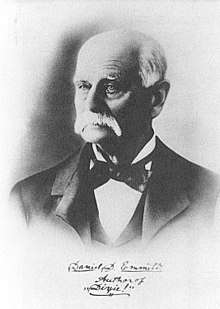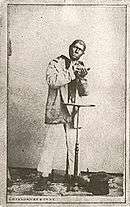Dan Emmett
Daniel Decatur Emmett (October 29, 1815 – June 28, 1904)[1] was an American songwriter, entertainer, and founder of the first troupe of the blackface minstrel tradition, the Virginia Minstrels.[2] He is most remembered as the creator of the song "Dixie".
Dan Emmett | |
|---|---|
 | |
| Born | October 29, 1815 Mount Vernon, Ohio, U.S. |
| Died | June 28, 1904 (aged 88) Mount Vernon, Ohio, U.S. |
| Allegiance | |
| Service/ | United States Army |
| Years of service | 1834–1835 |
| Awards | Songwriters Hall of Fame (1970) |
| Spouse(s) | Catharine Rives
( m. 1853; died 1875) Mary Bird ( m. 1879) |
| Other work | Songwriter |
Early and family life
Dan Emmett was born in Mount Vernon, Knox County, Ohio, then a frontier region. His grandfather, Rev. John Emmett (1759–1847) had been born in Cecil County, Maryland, and after serving as a private in the American Revolutionary War and fighting at the Battle of White Plains in New York and later in Delaware, became a Methodist minister in the then-vast frontier Augusta County, Virginia, and then moved across the Appalachian Mountains to Licking County, Ohio and also served in the Ohio legislature representing Pickaway County, Ohio in the Scioto River valley.[3] His father, Abraham Emmett (1791-1846) served as a private in the War of 1812 while his father served in the Ohio legislature. Notwithstanding his grandfather's career, Dan had little formal education. He learned popular tunes from his musical mother, and taught himself to play the fiddle. At age 13, Emmett became apprenticed to a printer and in 1836, when he was 21, enlisted in the United States Army.[4][5] He became an expert fifer and drummer at Newport Barracks, Newport, Kentucky.
He married Catharine Rives (born 1829) in 1853 in New York City, and they remained together until her death in 1875.[6] Four years later, Emmett married Mary Bird (or Browner; 1935–1917) in Chicago, Illinois; Emmett did not have children.[7]
Career
After receiving his discharge from the army on July 8, 1835, Emmett joined a Cincinnati circus. In 1840–1842 he toured with Angevine and other circuses as a blackface banjoist and singer.[5] Emmett was a Catholic.[8] In association with Billy Whitlock, Dick Pelham, and Frank Brower, he organized the Virginia Minstrels, which made their first appearance before a paying audience at the Chatham Theatre in New York City in 1843.[9]

Although blackface performance, in which white men painted their faces and hands black and impersonated caricatures of African-American men and women, was already an established performance mode at that time—Thomas D. Rice had created the character of Jim Crow nearly a decade earlier, and blackface had been widely popular ever since[10]—Emmett's group is said to be the first to "black up" an entire band rather than one or two performers. The group's full-length blackface performance is generally considered to have been the first true minstrel show: previous blackface acts were usually either an entr'acte for a play or one of many acts in a comic variety show.
Emmett is traditionally credited with writing the song "Dixie".[11] The story that he related about its composition varied each time he told it, but the main points were that he composed the song in New York City while a member of Bryant's Minstrels. The song was first performed by Emmett and the Bryants at Mechanics' Hall in New York City on April 4, 1859. The song became a runaway hit, especially in the South, and the piece for which Emmett was most well known. Emmett himself reportedly told a fellow minstrel: "If I had known to what use they [Southerners] were going to put my song, I will be damned if I'd have written it."[12] After the South began using his song as a rallying call, Emmett wrote the fife-and-drum manual for the Union Army. In 1862, Emmett published his own Fifer's and Drummer's Guide in cooperation with George G. Bruce. Emmett's song was a favorite of President Abraham Lincoln, who said after the war ended in 1865, "I have always thought that 'Dixie' was one of the best tunes I ever heard... I insisted yesterday that we had fairly captured it."[13]
Another writer named William Shakespeare Hays (1837–1907) (pen name: Will S. Hays) claimed to be the song's true author.[14] Members of the Snowden Family have also been named as writers of the song, namely John Baptist Snowden, a freed slave.[15][16]
Death and posthumous recognition
After a tour that was notably successful in the South, Emmett retired to his hometown of Mount Vernon in 1888[17] where he died on June 28, 1904, aged 88 years. From 1893 to the time of his death, he was aided by a weekly allowance from the Actors Fund of America. Emmett was inducted into the Songwriters Hall of Fame in 1970. A biographical film of his life was produced in 1943, titled Dixie. Starring Bing Crosby and Dorothy Lamour, it is a musical directed by A. Edward Sutherland.
Numerous schools, businesses, and other institutions in Mount Vernon, Ohio, are named after Emmett. The official memorial to him is a large boulder with a placard attached located in front of the Knox County Historical Museum.[18]
Emmett published at least 30 songs between 1843 and 1865, most of which are banjo tunes or walk-arounds. Between 1859 and 1869, he composed another 25 tunes that are in manuscript at the Ohio Historical Society in Columbus, Ohio.[5]
Notes
- "Findagrave: Dan Emmett". Findagrave.com. Retrieved March 13, 2019.
- The Oxford Companion to Music, Oxford University Press 1955 (Percy A. Scholes, ed.)
- http://wiki.lickingcountylibrary.info/Rev._John_Emmett
- U.S. Army Register of enlistments p. 267 of 440 available at ancestry.com
- Stevenson, Robert (March 13, 2019). "Emmett [Emmit], Dan(iel Decatur)". Oxford University Press. doi:10.1093/gmo/9781561592630.article.08773. Retrieved March 13, 2019.
- Cook County register of marriages available on ancestry.com
- 1951–, Newton, Michael (2010). The Ku Klux Klan in Mississippi : a history. Jefferson, N.C.: McFarland & Co. p. 95. ISBN 9780786457045. OCLC 567910513.CS1 maint: numeric names: authors list (link)
- Whitlock, who detailed the beginnings of the group, stated that the event was a benefit for Pelham. See Lawrence Hutton, "The Negro on the Stage," Harpers New Monthly Magazine, June 1889, p. 140. Such an event occurred on January 31. See The New York Herald, January 31, 1843, p. 3. The following day the Herald reported that the troupe would be appearing at the Bowery Amphitheatre, and an advertisement in February 6 issue refers to their first performance that evening.
- "Blackface Minstrelsy". Center for American Music, University of Pittsburgh. Retrieved July 15, 2015.
- Chisholm, Hugh, ed. (1911). . Encyclopædia Britannica. 9 (11th ed.). Cambridge University Press. p. 343.
- Letter from Col. T. Allston Brown to T.C. De Leon. Published in De Leon, Belles, Beaux, and Brains and quoted in Nathan 275.
- Speech given on April 10, 1865 and quoted in Hall 10.
- Abel, E. Lawrence (2000). Singing the New Nation: How Music Shaped the Confederacy, 1861–1865. Mechanicsburg, Pennsylvania: Stackpole Books, p. 47.
- Sacks, Howard L. and Sacks, Judith Rose (1993). Way up North in Dixie: A Black Family's Claim to the Confederate Anthem. Washington: Smithsonian Institution Press, p. 3.
- Petrusich, Amanda (July 13, 2020). "Why the Chicks Dropped Their "Dixie"". The New Yorker. Retrieved July 13, 2020.
- Occasionally taking part in performances: "Dan Emmett, whenever he is physically able and can get the chance, 'rosins his bow' for a dance party in Chicago."New York Times, July 10, 1887: 'Drop-Curtain Monographs'
- "Dan Emmett memorial re-dedicated - mountvernonnews.com". September 29, 2007. Archived from the original on September 29, 2007. Retrieved March 13, 2019.
References
- Crawford, Richard. An Introduction to America's Music. New York: W. W. Norton & Company, 2001.
- Hall, Roger Lee. Lincoln and Liberty: Music from Abraham Lincoln's Era. Stoughton, Massachusetts: PineTree Press, 2009.
- Lott, Eric. Love and Theft: Blackface Minstrelsy and the American Working Class. New York: Oxford University Press, 1993. ISBN 0-19-507832-2.
- Nathan, Hans. Dan Emmett and the Rise of Early Negro Minstrelsy. Norman: University of Oklahoma Press, 1962
- Robert Stevenson. "Emmett, Dan." Grove Music Online. Oxford Music Online.
- Dan Emmett at the Songwriters Hall of Fame
- Dan Emmett on IMDb
- Free scores by Dan Emmett in the Choral Public Domain Library (ChoralWiki)
- Free scores at the Mutopia Project
- Free scores by Dan Emmett at the International Music Score Library Project (IMSLP)
External links
